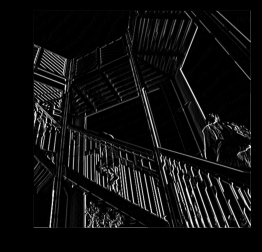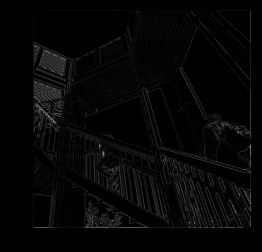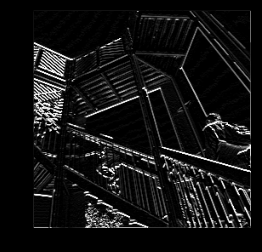#Wednesday’s Response: Convolutional Layers
-
In this exercise you manually applied a 3x3 array as a filter to an image of two people ascending an outdoor staircase. Modify the existing filter and if needed the associated weight in order to apply your new filters to the image 3 times. Plot each result, upload them to your response, and describe how each filter transformed the existing image as it convolved through the original array and reduced the object size. What are you functionally accomplishing as you apply the filter to your original array? Why is the application of a convolving filter to an image useful for computer vision? Stretch goal: instead of using the misc.ascent() image from scipy, can you apply three filters and weights to your own selected image? Describe your results. This is the original image.

This filter accentuates horizontal line
 filter = [[-1, -2, -1], [0, 0, 0], [1, 2, 1]]
filter = [[-1, -2, -1], [0, 0, 0], [1, 2, 1]]This filter makes the image really dark
 filter = [[0, 1, 0], [1, -4, 1], [0, 1, 0]]
filter = [[0, 1, 0], [1, -4, 1], [0, 1, 0]]This filter accentuates vertical lines
 filter = [[-1, 0, 1], [-2, 0, 2], [-1, 0, 1]]
filter = [[-1, 0, 1], [-2, 0, 2], [-1, 0, 1]]- When the convolutional filter is applied to the array, depending on the filter, certain structures in the pixels of the images are accentuated based on the struture of the filter. For example, the first filter above has three 0’s in the middle with numbers above and below, which means as the filter is passed over the image pixel values that are arranged horizontally will be represented more in the new image than other structures, and that’s why that filter accentuates horizontal lines.
- The convolutional filter is useful with computer vision because it is able to reduce the size of images while preserving important structures. This does two things, making the model less computationally expensive(reduce runtime) and also can exaggerate the features that the model is looking for, increasing the validation accuracy by emphasizing more generalizable structures.
-
Another useful method is pooling. Apply a 2x2 filter to one of your convolved images, and plot the result. In effect what have you accomplished by applying this filter? Does there seem to be a logic (i.e. maximizing, averaging or minimizing values?) associated with the pooling filter provided in the example exercise (convolutions & pooling)? Did the resulting image increase in size or decrease? Why would this method be useful? Stretch goal: again, instead of using misc.ascent(), apply the pooling filter to one of your transformed images.
- By applying pooling to the 3rd convolved image above, the important features of the image were preserved while the final image is 1/4th the size of the original image.

- The logic of maximizing values like the pooling above is that by only taking the highest pixel values of a grouping over the whole image would exaggerate the pixel values that are higher than the surrounding others, which increases the contrast between structures in the image. That contrast would help the model identify the structures in the images better and therefore make it easier for the model to predict the image’s classification.
- The resulting image is 1/4 of the size of the original image
- This method is useful because it allows to further reduce the size of the image while also preserving and even exaggerating the structures in those images
- This is the new array I got convoluting the 3x3 filter onto the 9x9 array
[[0, 0, 0, 0, 1, 0, 0, 0, 0], [0, 0, 0, 1, 1, 1, 0, 0, 0], [0, 0, 0, 1, 1, 1, 0, 0, 0], [0, 0, 0, 1, 1, 1, 0, 0, 0], [1, 3, 3, 3, 3, 3, 3, 3, 1], [0, 0, 0, 1, 1, 1, 0, 0, 0], [0, 0, 0, 1, 1, 1, 0, 0, 0], [0, 0, 0, 1, 1, 1, 0, 0, 0], [0, 0, 0, 0, 1, 0, 0, 0, 0]]
- By applying pooling to the 3rd convolved image above, the important features of the image were preserved while the final image is 1/4th the size of the original image.